Every organisation wants to be protected against cyber attacks. Protection against cyber-attacks gets harder every day, as the attacks become more complex, are ever-evolving, and are increasing in numbers. You want to make sure you are protected, as breaches and successful attacks will hurt your reputation and can cost your organisation millions. How can (future) customers trust you again afterwards?
What is a SOC?
Before we can explain what a managed SOC is, we’ll explain what a Security Operations Center (SOC) is. As the word ‘centre’ implies, it’s the physical location of an information security team. The team is responsible for monitoring and analyzing an organization’s security posture on an ongoing basis. They also actively prevent, detect, and respond to cybersecurity incidents.
In a SOC, the security team uses a combination of technology solutions and a strong set of processes. The team there usually consists of security analysts, engineers, and managers who oversee the security operations. The team works closely with the incident response team, who ensure that security issues are acted upon quickly after discovery.
Not all organisations are able to set up a Security Operations Center. This has several reasons but is often related to a lack of resources. They lack in-house expertise, time and costs to set it up, etc. That’s why outsourcing your SOC can be very valuable.
Managed SOC explained
Managed SOC, or SOC as a Service, offers organisations external cybersecurity experts who monitor your cloud environment, devices, logs, and network for threats. This is based on a subscription model, where you pay a monthly or yearly fee to ensure that threats are detected and responded to accordingly.
With managed SOC, there is 24/7 monitoring of your IT infrastructure, without making a significant investment in security software, hardware, security experts, training, and more. You can have quick access to a SOC and start monitoring cyber threats, which will improve your organisation’s security.
The service that a managed SOC team delivers is Managed Detection and Response (MDR).
Why outsourcing your IT security is not scary
Many decision-makers in the IT department find it difficult to outsource their IT security. This is concerning because most organisations don’t have the knowledge and manpower in-house to keep their security up to date.
What is keeping companies from outsourcing?
- They want to keep complete control
- Privacy-sensitive data
- High cost
We understand these concerns, but they don’t always apply.
You won’t lose control of your security
Companies fear that they will lose control over their security when they outsource it. But, when outsourcing your security, you will not hand over all responsibilities and risks to an external party. As a company, you will remain ultimately responsible. That is why we rather speak of ‘out tasking’, because you move certain tasks to a Security Operations Center.
With a dashboard, you can keep real-time insights into what is happening within your organisation. The SOC team will notify you when there is a threat or breach in your network and provides feedback at a priority level. You then take action yourself, based on the solutions provided by the SOC team. You can also choose to make use of an incident response team. They will act on the threat on your behalf.
Your data will stay safe
Some organisations find outsourcing their IT security difficult because another company will get access to privacy-sensitive data and the chance of a leak will become bigger. This is a misconception because when you outsource your security to a SOC, the data remains in your company. A SOC will merely look at the metadata and log files. This means that a SOC can’t see the content of a file, but only what type of file it is, such as a .docx or .pdf.
The big advantage is that an external SOC is specialised in the protection of privacy-sensitive data. Our SOC, for example, is GDPR compliant and ISO-certified.
The cost to stay safe
With the rapid growth of cybercrime and the damage that can be done with it, it’s safer to invest in your IT security than to undo the damage. According to the IDC, an organisation needs to spend between 7% and 10% of its IT budget on security, but many organisations do not.
Investing in IT security specialists yourself requires a large investment in hiring and continuous training. Next to that, finding a qualified specialist is becoming difficult due to fierce competition. A Security Operations Center already has the right people in-house who can support you and receive the training they need to do their job properly.
Software used in a managed SOC
The team that monitors your network and systems does this with a Security Information & Event Management (SIEM) platform. It provides real-time analysis of security alerts and enhances threat detection and response capabilities. SIEM helps to give insights into the daily activities within your network and is the foundation of an effective security framework.
Choosing the right SOC as a Service
When choosing a Security Operations Center, it’s important that it has a clear Service Level Agreement (SLA) and the right ISO certifications. But you can find these criteria at any SOC. What is more important is that the people at the SOC have the right skill set and that you trust them. You will be working closely with the SOC team, thus it’s important to know how they work, where they get their information and how fast and with what parties they come to action in case of an incident. Read more about Nomios' managed SOC service.
Understanding the basics of cybersecurity
Get your copy of this 70+ pages whitepaper, to learn more about cybersecurity and to feel comfortable in a security conversation. Or get in touch with us directly if you find this topic of interest.

Latest news and blogs

Cybersecurity Artificial Intelligence
AI in cybersecurity: A double-edged sword
AI enhances cybersecurity with quicker threat identification, proactive measures, and automated efficiency, yet presents challenges like evolving threats, ethical concerns, and a skills gap, necessitating a comprehensive defense approach.

Cybersecurity
Secure your future: Top cybersecurity trends for 2024
We’re on the brink of a new year again. Time to learn all about the most important and interesting cybersecurity trends for 2024.

Mohamed El Haddouchi

SOC Cybersecurity
Navigating the 2024 cybersecurity landscape: Key trends in SOC security
A security operations centre (SOC) offers the security tools and knowledge that you need to keep your IT environment safe. Read all about the SOC security trends of 2024.

Avinash Shet


